
How do designers experience their cities as locals? No two people, let alone architects, perceive even the most frequented cities in the same way. There's no city that embodies that like the way Los Angeles does it. Beyond the ample sunshine and smog, juice diets, drought consciousness (or not), and the traffic jams that make up parts of present-day L.A., this jigsaw puzzle of a city perpetually intrigues and confuses both tourists and locals alike.
To get a fresh perspective on what to do around town, in addition to seeing the most obvious L.A. landmarks, Archinect got in touch with Ball-Nogues Studio co-founder Benjamin Ball to share some of his own travel tips. Give his suggestions below a shot and experience the City of Angels with some devilish fun.
Night Gallery and Francois Ghebaly Gallery

Night Gallery used to open at 10 pm when it occupied a dilapidated mini-mall in Lincoln Heights. Today, it has regular hours and is located behind a strip club in the vast industrial territory just south of Downtown. Connected to Night Gallery via razor wire-protected courtyard is Francois Ghebaly Gallery. These galleries are some of the largest spaces in the City showing promising LA artists. Try to visit on an evening when both have openings.
The Los Angeles Herald Examiner Building

Julia Morgan deserves more attention. With William Randolph Hearst as her patron, she built the Herald Examiner Building in 1915. After the paper published its last issue in 1989, the Mission Revival icon became a film location and it was closed to the public. Any sightseeing stroll along the Broadway Theater Corridor deserves a short detour to 11th Street to see its exterior and try to get a look inside.
Angels Flight
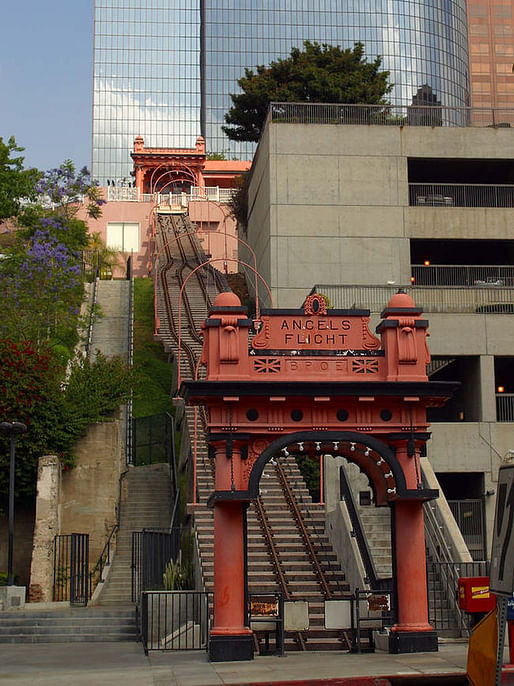
The Angel’s Flight is a funicular built in 1901 and it is the best way to make the uphill journey between Grand Central Market on Hill Street and the Museum of Contemporary Art on Bunker Hill. Over the year’s its been closed in order to remedy some safety issues. Hopefully it will be operating again soon.
La Cita Bar
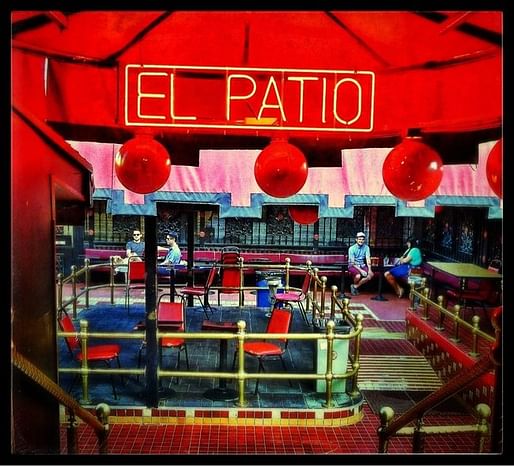
LA’s fanciest not-so-dive bar showcases an array of happy hours and dance parties that cater to niche musical tastes ranging from vintage LA punk during Angry Hour to old school Hip Hop during Hip Hop Happy Hour, to Mustache Mondays. While the DJs are always knowledgeable, the interior architecture suggests a lovechild born of Martin Scorsese’s Good Fellas and a Mexican Circus.
The Seating Pods at Hotel Bonaventure
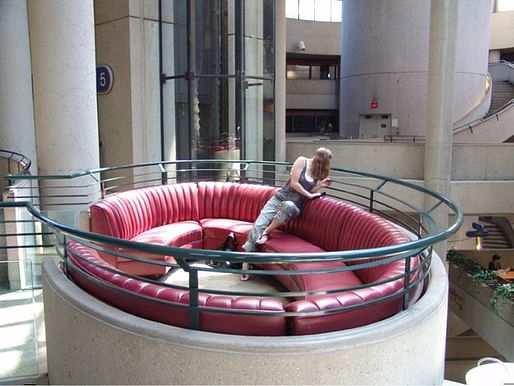
The towering concrete lobby of John Portman’s Hotel Bonaventure is not a Brutalist masterpiece. It is an expansive five-story atrium cum dead mall that despairingly hosts divorce lawyers, psychics, and unexceptional Japanese fast food places. Although it failed to become the thriving “City-within-a-City” that Portman promised, its three dimensional circulation system of bridges and outcroppings suggest a Paranesi Prison while providing opportunities for illicit adventures should one play it cool with the roving hotel security staff. Most notable are the oval shaped banquets that cantilever four stories above the lobby. If Portman believed these would serve as conversation pits, I’m astonished — today they occasionally host a sleeping businessman while others house exercise equipment (which never gets used). I challenge you to do some fellatio, cunnilingus or bong hits in these personal party pods. My guess is you won’t get caught.
HM157

Frank Lloyd Wright famously said, “Tip the world over on its side and everything loose will land in Los Angeles.” Tip Los Angeles over on its side and every unglued performer, musician, anarchist and delightful oddball will land in HM157 and put on a show in the living room. What is HM157? Architecturally speaking it is Historic Monument 157 (a designation bestowed by the State of California), a dilapidated Victorian farmhouse across a six-lane street from a McDonalds Playland and next to a Mexican Seafood restaurant. The semi-urban surrealism is enhanced by a gigantic “for sale” sign in the frontyard (a relic of the house’s former function as a Korean real estate office) surrounded by an organic vegetable garden and palm trees. Anything can happen here — fashion, performance, musical events, workshops.
Maestro Charon Nogues (full disclosure, my partner Gaston’s wife) is full of aphorisms you will absorb via osmosis after a few visits like “Fashion Mother Natures Laws of Adaptation into the trend worthy” or “Being bad has been done to death (Yawn)”. It is a place “dedicated to the propagation of all positive possibilities.” Sound a little utopian? Sure it does, but utopian ideals are necessary to put a reunion show by pre-punk aliens Zolar X on the same stage as a birthday clown named Laffy Pants, then follow up the next week with “square dancing revolutionary” Ms. Cory Marie Podielski and an evening of Chiptrash by artists playing Gameboys. Through the generous act of goofing around, HM157 does what Los Angeles is bad at: Cultivating community.
Camp Fashion District
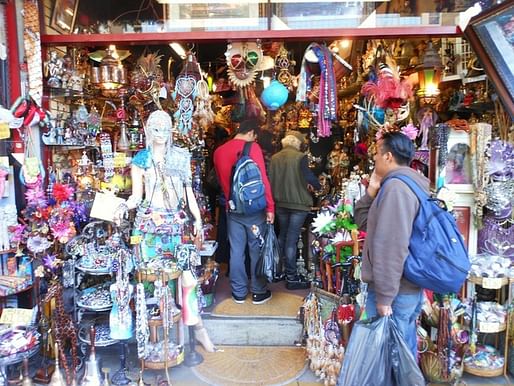
The Fashion District is the closest thing LA has to a Middle Eastern bazaar. Block upon block of fabric sellers and wholesale clothiers hock their wares to the trade and retail shoppers alike. You won’t find these offerings at the Beverly Center (LA’s most celebrated mall). During the daytime it is arguably the most bustling retail business district in City, at night it is a campground. After the shops close, transient people set up Nordic dome tents and refrigerator boxes in neat rows along the sidewalks. They assemble their dwellings in groups of three to five, perhaps for mutual protection. Some of the campers don’t have tents; they have sleeping bags that they align in even rows with their feet pointing toward the street. A consistent sized territory surrounds each of them; it is a tight order that reminds me of beds in military barracks. They camp beneath awnings of stores with names like Parisian Dreams. By 10 pm, the campsites are motionless, the campers asleep. At sunrise, the streets are alive again, the campers disassemble their homes, pack them into shopping carts and disappear before the street sweepers arrive to clean up the trash and the cops issue tickets.
Bong Row
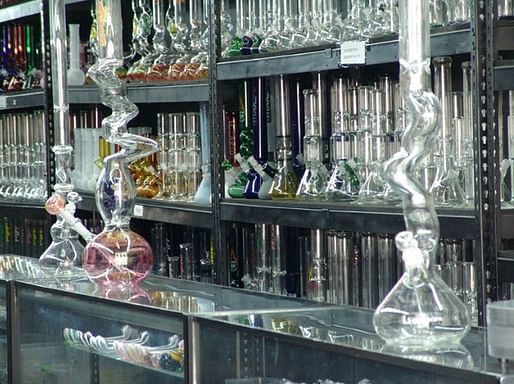
Skid Row, ground zero for most things homeless in LA lies a few blocks from a district we dubbed Bong Row. A collection of approximately one dozen storefronts along a single block on Third Street, Bong Row is a wholesale district for various “tobacco” smoking products. The shop owners, mainly from Central Asia, peddle a staggering array of hookahs, glass pipes, vaporizers, and other paraphernalia. Downtown LA also hosts production facilities for these items and I was recently invited to observe craftsmen blowing and revolving the bongs by hand. Craft theorist Howard Risatti might describe the process as conception and execution integrated in a subtle feedback system, the physical properties of the materials encountering conceptual form and conceptual form encountering physical material; thinking and making, visualizing and executing going hand in hand. Each one bears the unique marks of its maker. The new generation of glass bongs is formally intriguing; the contorted tubes suggest segments of intestine plucked from the abdomens of Hajime Saroyama’s fantasy cyborgs. Does MoMA have any bongs in its Design collection?

Benjamin Ball
Ball-Nogues Studio (established 2004) is an integrated design and fabrication practice operating in a territory between architecture, art and industrial design, led by Benjamin Ball and Gaston Nogues. Their work is informed by the exploration of craft. Essential to each project is the "design" of the production process itself, with the aim of creating environments that enhance sensation, generate spectacle and invite physical engagement. The Studio has exhibited at major institutions [and they] have received numerous honors. The Studio is currently working on permanent public commissions for Sound Transit Bellevue Station, Central Washington University, Fort Dodge Middle School and Chicago Transit.
Check out Archinect's previous travel guides here.
No Comments
Block this user
Are you sure you want to block this user and hide all related comments throughout the site?
Archinect
This is your first comment on Archinect. Your comment will be visible once approved.